An Italian Anthropologist in London (2009-2010)
An Italian Anthropologist in London (2010) è stato il diario che ho tenuto per tre mesi online durante un periodo di lavoro a Londra, osservando somiglianze e differenze culturali a partire dalla mia vita quotidiana e l’esperienza della città. Il sito gratuito ove era ospitato non esiste più, di conseguenza ricopio qui integralmente i testi pubblicati all’epoca.
20/10/2009
Vegan Cafè, Anarchists, and Autumn Smell
Hackney is a lovely place. A little scaring, but I guess it’s only because I’m a newby, and I can’t recognise people’s attitudes by their faces yet – as one can do when is familiar with a place. It will take time. And I’m not used to so many black people around. It’s not a racial judgement, mine: it’s a realization. It’s kinda weird to wander around these white fancy terraced homes, and seeing old black people talking/smoking at the front door of them… I mean: this is the stereotype we have of Jamaica, not of London! But still is nice. And they all great you!
Greeting people you don’t know seems to be the easiest and most common thing here. I began a walk of the neighbourhood in late morning yesterday, to meet up with Brigida in the afternoon, and walking down the street to reach the local shopping area to buy some food I was greeted by all the people I saw without knowing them: a woman at the front door of her house, an old man while mending his car, a young guy riding his bike, the dustman who was sweeping the street.
This was so weird!
After a few blocks, I eventually reached ‘my’ place: the Pogo Cafè, the meet-up point of the anarchists/squatters of the area – vegan, gluten free and definitely laid-back. With lovely people inside, sharing experiences about squatting and travelling, or talking about any issues, or simply sitting on a couch and reading. Brigida and I had lunch there and could grasp some words form the tables around (you know: we are anthropologists, always spying other people’s lives) – definitely nice ones!
We ended up with a long walk, reaching another nice street – Broadway Market, where on Saturdays there’s a vegetables & fruits market – full of fancy people, where you unpredictably feel ‘home’ even if it has nothing in common with the one you left in your hometown.
And again, walked through London Fields. The leaves mixed with the wet ground produced an autumn smell, and reminded me of many other good moments in my life – like a time warp where time bends on itself.
20/01/2010
Chronicles from the Underworld (Lost in the Supermarket, Kultur Shock, and Another Little Sister)
Another day wandering around – still not knowing what to do next months, and taking the day off to go shopping and then relaxing, as I needed to… Went to Tesco in the area of Hackney Central Station: “I’m lost in the supermarket / I can no longer shop happily”. Little differences for an anonymous non-place. I found my way by talking to people: “God gave us the tongue to be able to ask directions” – as I used to say to strangers on my first Inter-rail when I was 18, and everybody wondered how this young girl could feel home everywhere, even in perfectly unknown places.
I spent the evening watching with my flatmate (and landlord) “The Boat That Rocked” (on a big screen & videoprojection: sometimes is not bad to enjoy others’ richness!), a lovely good film, with an amazing sountrack, about the first free radios in UK in late 60s. Rebels, pirates – we keep on building on that, isn’t it? The last romantics…
Thuesday passed in writing emails to universities, then, in the evening, I eventually went to one of the best concerts I’ve seen the last years: Kultur Shock, playing at the Camden Underworld. The Underworld is a music club, in the basement of a tipical victorian building. A good band played as supporters, Drunken Balordi. Fine gipsy punk, slightly folk too, sometimes. But really good.
And then Kultur Shock went on stage. And their songs and attitudes are really engaging and immersive! Take a look at the video to have an idea of the two hours I had the pleasure and honour to join. The violinist was the sexiest woman I’ve ever seen, and the singer had such a powerful voice and shy attitude at the same time, that you felt like crying at the lyrics of their songs.
Little differences: people in Italy dance. With different styles, some being a real vision of beauty, some others making you smile as they still have to train – but yet, they all dance and move according to the rythm. Here none of the people of the audience could dance, not even move to the rythm. Running, punching, kicking or, less dangerously, simply jumping. No surprise that “the music of the people who couldn’t play” – the punk – was born here by these beat&melody unconscious people! But I’ve been told that *the norther people* (expecially the ones from the area of Liverpool or the ones who come from different areas of England and then joined together) are much better, ahahah!…
The concert ended at 11pm – quite surprising for me used to concerts beginning at that hour, but this meant no worries in coming back. Even when not knowing where the bus stop to come back was. I asked a little young girl with violet hair, piercings, black clothes, with the @ stuck everywhere on her light jacket. And she moved from her way to lead me to the right bus stop – walking in the coldness of this humid town. “Aren’t you cold?” I asked. “Yes” – she replied with a smile. We said goodbye at the bus stop, and she straight off kissed me on my cheeks. I will probably never see her again, but she is part of my personal beautiful world now – a sister, a mate, an ‘accomplice’ in making the *wider society* better, and more mutually supportive. So thanks, my dear: wish you to keep on behaving this way!
25/01/2010
Is This an Ordinary Day (a Walk in Camden, Unexpected Kindness, and British Good Food)?
Waking up quite early in the morning last Saturday – 4 cats around are not really the best company to sleep as long as you would like to! – I made up my mind to get to Camden Lock Market and have a walk around there before meeting in the afternoon with the London Art & Culture group.
I took the overtrain and then walked down the railway station to reach the market area. Camden is a folkloristic place to say the least, where people go to exhibit themselves and tourists buy any kind of fake punk stuff to have the feeling they recall an old memory, born and developed here, who affected them not only in teenager years – fucking seductive for the ones of us who still live/feel that way.
I mixed with this human flow, and became a further stranger among them. I ended up eating a wonderful seafood paella – sitting on the pavement in front of the channel. Sun was kissing me and about other 50 winter lizards, whilst looking around and thinking about my best friend and how much I desired to have her here with me to share this.
‘Kindness’ is the password, and no matter at the moment that it might sometimes be connected with hypocrisy – althugh I didn’t notice this happening around me up now. “Anything bad that might happen to you, if you go through any crisis or feel like crying or just need to talk, call me!” – a complete unknow lovely girl from the London Art & Culture group told me this after visiting together a contemporary art exhibition last Saturday at Saatchi Gallery. Yes, this is London, something very different from the cold, cool town of our imagination. The exhibition wasn’t astonishing: much of the works was somehow already seen – it seems to be quite hard to say something really new in contemporary art! But at least I met lovely Londoners in it – Rebecca and Samina. Yes, my dear ladies: I feel a little more confident now so I’ll be able to join you also in the evening next time!
Sunday I met Brigida and her friend Ula to go to a free shop in the area of Spitalfields. But we soon ended up, with some more mates, to join a pub – one of the most messed up place I’ve ever been, with such a loud volume music you couldn’t talk, so stuffy that you can understand why swein flue spread so much here, and with such a bad and mixed taste in forniture and decoration that you don’t need to get drunk to throw up. This to tell the truth, but nervertheless the building was really lovely, and in any case there was a very nice and relaxed atmosphere – not to mention the brilliant Brigida’s friends and the funny conversations we had with them!
We finally went for dinner in a place that deserves a mention, as everybody say UK food sucks: no, it doesn’t (when you have an ‘anthropologist of food’ leading you to *highly selected* bistrots such as the St. John restaurant where you get local food cooked according to ancient recipes. What I tasted recalled no memory in my head, it was something unexpected and so good that you… ahem… can’t believe it’s British!
17/02/2010
Picturing London (The Map Room Is Open)
Do not trust maps, in London, they don’t tell the truth: what you think is nearby on the map, will always be elsewhere in the reality. Walking is something I do really enjoy. Covering neverending distances is something I enjoy less, but still is a wonderful way to get to know a place. When I don’t walk, I observe this town from above: from the upper floor of the buses, from the windows ot the overground train crossing the houses at their somthing like second floor of the houses.
And I grasp instants of people lives: a white man gardening the backyard of his place, a woman caring at her kids inside a sad grey block, a couple of gothics walking to reach Camden Lock. I take the chance of any interview and any step I do in my job search (yes, now I’m searching for a job – it seems there’s always something to search for here in London, doesn’t it?) to discover new areas of the town, but at the moment I mostly had the chance to explore – if you look at a standard map of London and use the Thames to split the north and the south of the town, and the City as ‘hardcore’ of all the issue – some east, some north-east, some north-centre and some south-east of the Thames.
I had to meet Chris, a few days ago, at the 56a Infoshop Social Centre. You can reach that place taking a couple of buses from Clapton Pond (where I live) to Walworth and, as I never give up any chance to play, I did it also this time. This means that, without any ‘academic’ intention about questioning issues such as place, standard maps, distances and cultural assumptions about the boroughs I was going through, I jumped on a bus, reached the upper floor and began shooting pics as a common tourist. I wasn’t really interested in anything in particular. I just took a pic any time I had a question or some stupid reflections were coming up to my mind.

Clapton Pond seems like a fairytale, notwithstanding its poverty. A fountain, a small wood bridge, a few trees, and probably ducks (not in this season). In front of it, waiting for the bus, you are offered the sight of some anonymous shops and a phone box sunk in the cement of the pavement (it’s a pretty traumatic experience calling from there, as the pavement itself is partially lift so that you are forced to assume a diagonal position with your body as well, and hope not to fall out of your centre of gravity).
From the bus I take a few pics, perfectly knowing the areas of the town I’m in – and being able to figure them both in my mental map of London and in the memory I have of the standard map of it, but still… where are the borders among the different boroughs? And how comes that sometimes boroughs are not written in some maps, but smaller areas within them are? Which is the reason why a map includes the name of a smaller area and skips out the one of a bigger borough?
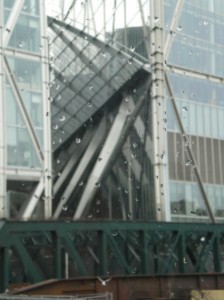
The freedom of enjoying this small trip gives me the chance to notice and joke about the places, so that I feel moved as I see a huge building in cement, glass and steel with two high wings… and something that seems just fallen down between them. I can imagine it desperately crying to the people walking quickly in the streets nearby, and I can hear its voice and story: “Hey, you, can you help? I’m a piece of the roof, I fell between the two wings of this building and it’s so narrowed that I can’t stand up anymore so to climb it and get back to my place… CAN SOMEONE HEEELP?!?!?!?!”.
Chris (Captain Mapp) draws maps, and makes people do the same. Then he collects the works produced and organises exhibitions of them. I ask him what’s next, when he leads a workshop or a walk with people, and they produce their maps of a place, or tell him their stories/memories about a neighbourhood in the past. “What’s next? Nothing!” – he replies. All is spent in the dimension of the actualising, in a full situationist style.
I got to know him whilst searching online for maps and mapping in London, and I met the project “THE MAP ROOM (is open…)” – that exists also in reality as “suitcase” archives of maps, projects, festivals he produced (or led the production of)… The maps we are talking about are not the usual ones, with standard points of reference anybody could use to orientate in the space: they are subjective, emotional, symbolic, and mostly depict their author, his/her memories, points of view and desires. They reflect the sense of a place by those who live it, and for this reason both a (psycogeographer) artist and an anthropologist can be interested in them. I’m starting wondering how an ethnographic project I have in my mind about the issue of “personal and collective identity” could match with his work and be developed by our different, but closed, gazes. One of these days, I will find out the time to write a draft about it, and ask Chris to give me his feedbacks and work on it himself too.
20/02/10
It’s All London Baby (Complaining the English Way, Hygienic Norms, and Some Healthy Confusion)!
I had a wonderful dinner last Thursday with a few (girl)friends – where I learnt to complain in the English way. “Complaining the English way” means that instead of mumbling and telling yourself you will never go again in a place you disliked for something due to the service or the food, you make it notice to the manager of the place, who will do its best to compensate you for what went wrong – with a dessert, or in any other fancy way. Cool, isn’t it? I like it – my critic attitude is definitely fulfilled by it.
Anyway, we had a lovely evening any anthropologists would dream about: talking with some other intellectuals, not from your field, about what we notice as similarities and differences between cultures – and Brigida and I are deeply embedded in this educational attitude and in broadering our knowledge about human cultures beyond academic community. So we spent some of our time teaching about hygienic norms and conceptions among gypsies, Italians and British people. When you take the shower in the morning, for example, we first use the bidet, and then take the shower: yes, we wash ourselves twice. And no, the bidet is not “that piece of forniture that fill the space between the WC and the sink”. Just as we would never use the small towel – the one we use to dry our privates – to dry our hands and face as well, for which we use the bigger towel. Of course, we had finished our dinner before talking about these issues – it wouldn’t be nice to talk about intimate washing whilst eating…
The day after I had what I consider the best interview I ever had for a job with whom could be considered at a first sight as a ‘weird’ professor – as I couldn’t even understand, before meeting, is she was a ‘she’ or a ‘he’. Her name is in fact Sue, but she uses as well the name Johnny to refer herself. On the net I saw some of her articles signed either with the masculine or the feminine name – so I couldn’t really understand. But at a certain point I didn’t worry about it anymore. “Whatever!” – I told myself, a comment really nice I learnt here, that means something like: “Whatever it is, it’s not an issue of mine, and/or it doesn’t make any difference” – it’s all London, baby!
Anyway, the inverview didn’t give me (at least not immediately) a job, but opened up some opportunities. What’s more important is that it has been the best inverview I had in my life: two hours spent 1) with a passionate person willing to learn about my researches, attitudes, aims, 2) listening with a sincere interest and care to me, 3) telling me a true and objective analysis of what I’ve done up now (so congratulating me for the good things as well as criticising for the wrong ones), 4) suggesting me the further steps to achieve my goals (and not forcing me to necessary do this in her department), and showing to be a people person with a deep and warm kindness to support me – like she could see my past in my eyes.
Unbelievable! Something special I wish all the ones I love to live by/with someone else such as a potential mentor/tutor. So I’m keeping on thinking/wondering/reflecting about this still now. I’m getting every day more confused, but still in a serene way. Thinking about next steps. What I want to do. Where I want to live the next few months. What am I actually looking for in general…
10/05/2010
Hackney (London) /1
Il laboratorio di cui parlo oggi è in realtà avvenuto lo scorso 24 aprile 2010 ad Hackney, Londra (UK), ed nato dalla mia volontà di giocare con altre persone – con il disegno, la memoria, il dialogo e la percezione di un luogo urbano – nel quartiere in cui vivevo, un’area del nord-est della città caratterizzata dalla presenza di immigrati di diverse origini culturali o religioni differenti . Tali comunità sono in realtà relativamente separate tra loro in aree diverse, all’interno dello stesso quartiere, in base alla distanza dal centro della città (la cosiddetta ‘city‘) così che alla fine ciascuna specifica identità culturale abita questo triangolo/porzione di corona circolare delimitata a ovest dal quartiere invero più fashio di Islington e a est l’area più depressa ma anche modaiola di Tower Hamlets.
In mezzo a tali presenze, che annoverano pachistani e indiani, così come africani di origine caraibica e infine – nella zona più a nord – ebrei ortodossi, si muove tutta la fauna di giovani bohemien, artisti (veri o presunti), studenti, e via dicendo. Fino a pochi anni fa terra di nessuno in mano a bande di ragazzini e ad alta densità criminale, il quartiere è ora stato rivalutato da generose ristrutturazioni, recuperi di spazi industriali, e rivalorizzazioni di aree caratteristiche con l’incremento di attività commerciale (cfr. il Broadway Market, mirabile esempio di efficace invenzione di tradizione).
Hackney ospitava in quel periodo, ed è il luogo ove si svolse il laboratorio, anche un centro occupato/sociale di ispirazione libertaria, dove le persone che lo desideravano potevano recarsi e chiedere la disponibilità dello spazio per realizzare una qualche attività gratuita per la gente della zona.
Nei primi tempi in cui ero a Londra, così come ho scritto in altri post, contattai Captain Mapp, che aveva già una lunga esperienza di conduzione di laboratori quali quello che mi accingevo a proporre. L’idea era realizzare una giornata/pomeriggio di incontro, suddiviso in due momenti con una pausa in mezzo, nel quale portare i partecipanti – che in qualche modo avevano qualcosa a che fare con il quartiere o perché vi vivevano, o perché vi si recavano per lavoro, o ancora perché lo attraversavano per qualche ragione nella loro vita quotidiana – a disegnare prima una mappa di come percepivano affettivamente il luogo, e quali ne fossero i luoghi simbolici dal loro personale punto di vista – e poi a disegnare tutti insieme una mappa collettiva del quartiere.
Captain Mapp fu subito entusiasta dell’ipotesi e così decidemmo di svilupparla insieme, preparandone l’articolazione in un pomeriggio, realizzando i flyers (dove lui li disegnò e impostò graficamente, mentre io ne scrissi i testi e inventai il nome del progetto Un/Common Places) e la promozione relativa.

© Cristina Balma-Tivola
I ragazzi del centro occupato di Mare Street (quello era il luogo che ci avrebbe ospitato) ci diedero un aiuto enorme, volantinando e attacchinando i flyers ovunque – pure su una pubblicità che riecheggiata il concetto di mappe, ma che essendo un’azione istituzionalizzata e pubblicitaria, poco aveva a che fare con il senso profondo del nostro gioco, invero molto serio, sulla memoria, il luogo e l’identità.
Il giorno del lavoratorio io e Chris (il capitano!) mangiammo qualcosa insieme fuori dal centro occupato, poi aspettammo l’arrivo dei partecipanti. Quando fummo una ventina di persone, nell’area antistante il bar del centro, iniziammo il lavoro, spiegando in pochi minuti la nostra proposta e le ragioni di desiderio di conoscenza e di condivisione delle percezioni del luogo che vi stavano dietro. Decidemmo di cominciare con un gioco, consistente nello scrivere su pezzetti di carta, tre posti specifici simbolici di qualcosa – nel bene o nel male – per ciascuno di noi all’interno del quartiere. Raccogliemmo i foglietti e ne raggruppammo secondo i luoghi comuni indicati, chiedendo chi li avesse scritti. Persone diverse per genere, età, provenienze riconobbero che in alcuni casi indicarono lo stesso posto. Cominciammo a chiedere le ragioni di tale scelta e i legittimi autori le spiegarono. Il ghiaccio era rotto.
Hackney (London) /2
Di qui chiedemmo ai partecipanti di cominciare a disegnare ciascuno la propria mappa individuale del quartiere, e quelli che seguono sono momenti e risultati del loro/nostro (perché la disegnammo anche noi!) lavoro.
 © Martina Macconi
© Martina Macconi
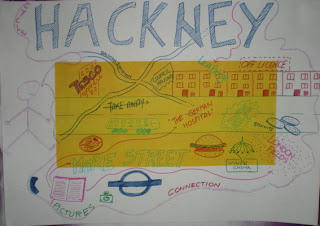
© Cristina Balma-Tivola
 © Cristina Balma-Tivola
© Cristina Balma-Tivola
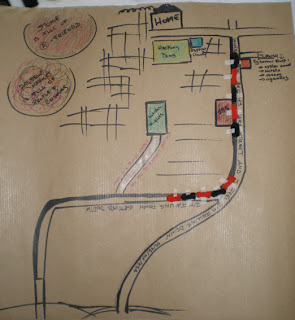
© Cristina Balma-Tivola

© Cristina Balma-Tivola
 © Cristina Balma-Tivola
© Cristina Balma-Tivola

© Cristina Balma-Tivola
Le mappe così realizzate vennero appese al muro, e le persone – in un momento di pausa in cui mangiammo torte e bevemmo the gentilmente preparati dai ragazzi del centro – man mano illustrarono agli altri partecipanti la loro mappa. Emersero non solo ricorrenze interpretative dei luoghi, ma anche sensazioni rispetto a questi, e molte osservazioni che investivano la percezione sensoriale del territorio. Per tutti, la grande sorpresa del verso degli uccelli, la presenza di animali abitualmente percepiti altrove come selvatici, e la frequente ricorrenza di spazi verdi.
La seconda parte del lavoro consistette nella creazione di una mappa collettiva, e visto che non si riuscivano a individuare modalità per sbloccare l’impasse della sua concezione, Chris si buttò a terra su un grande foglio che avrebbe ospitato la nostra mappa collettiva e chiese che qualcuno disegnasse il contorno del suo corpo. Facemmo tutti lo stesso, quindi contemplammo le sagome e indicammo cosa ci ricordavano. Da qui macro-temi, nei quali ciascuno, poi, liberamente, inserì scritte e ulteriori disegni.
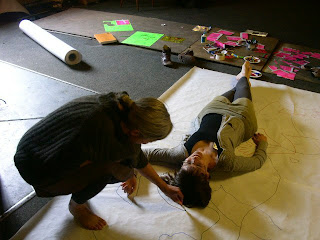
© Martina Macconi
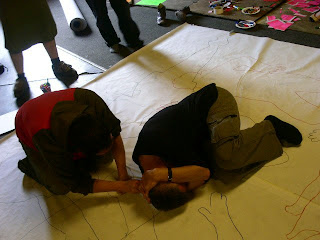
© Martina Macconi

© Martina Macconi

© Martina Macconi
Fu così che avemmo temi quali gli animali, il cibo, le cose nocive, le paure, i motivi di attrazione e altri ancora. Il laboratorio aveva messo insieme persone di diversa età e di diverso genere, per non menzionare le nazionalità rappresentate e le ragioni del legame col quartiere. Ci aveva fatto ragionare e stare insieme, in modo libero e concreto, e giocando ci aveva permesso di conoscerci, e produrre qualcosa di individuale e collettivo allo stesso tempo. Memoria, interpretazione e desiderio s’erano incontrati d’incanto – anche solo per un istante – in una microcomunità estemporanea. E felice.
